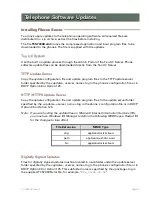
Teo IP Telephone Network Administration Guide
Page 74
13-280132 Rev. Q
expected packets). These are normal packets that have average transmission delay, but
with minimal jitter delay or packets that arrive early.
Delayed packets may or may not be played, depending on jitter buffer settings.
Delayed >10ms
– total number of packets received later than 10ms after the expected
arrival time; also expressed as a percentage of total delayed packets (>10ms packets)/(total
number of expected packets).
Delayed >20ms
– total number of packets received later than 20ms after the expected
arrival time; also expressed as a percentage of total delayed packets (>20ms packets)/(total
number of expected packets).
Delayed >30ms
– total number of packets received later than 30ms after the expected
arrival time; also expressed as a percentage of total delayed packets (>30ms packets)/(total
number of expected packets).
Delayed >40ms – total number of packets received later than 40ms after the expected
arrival time; also expressed as a percentage of total delayed packets (>40ms packets)/(total
number of expected packets).
Delayed >50ms
– total number of packets received later than 50ms after the expected
arrival time; also expressed as a percentage of total delayed packets (>50ms packets)/(total
number of expected packets).
Delayed >60ms
– total number of packets received later than 60ms after the expected
arrival time; also expressed as a percentage of total delayed packets (>60ms packets)/(total
number of expected packets).
Delayed >70ms
– total number of packets received later than 70ms after the expected
arrival time; also expressed as a percentage of total delayed packets (>70ms packets)/(total
number of expected packets).
Delayed >80ms – total number of packets received later than 80ms after the expected
arrival time; also expressed as a percentage of total delayed packets (>80ms packets)/(total
number of expected packets).
Underflow Events
– total number of jitter buffer underflow events. An underflow occurs
when the jitter buffer “runs dry”, usually due to an interruption in the packet stream. This
causes an audible dropout in the audio playback until enough additional packets are
received to fill the jitter buffer to the average value setting.
Overflow Events
– total number of jitter buffer overflow events. An overflow sometimes
occurs when a burst of packets arrives that exceeds the capacity of the jitter buffer. In this
instance, the most recent packets are retained and the earliest packets in the jitter buffer
are dropped to make room. This causes an audible “skip” in the audio playback to restore
the jitter buffer contents to the average value setting. In some cases, an overflow event
may follow an underflow event if a group of packets experience unusual burst delay. An
overflow event can also occur on a long-duration call, due to slight differences in packet
rates between sender and receiver.
Total Packets
– total number of expected packets in the call, based on RTP sequence
numbers (last received RTP packet sequence number) – (first received RTP packet sequence
number). This number may be higher than the actual number of packets played during a
call, since it also includes lost packets and underflow packets.
Содержание 4101
Страница 6: ...Teo IP Telephone Network Administration Guide Page 6 13 280132 Rev Q ...
Страница 16: ...Teo IP Telephone Network Administration Guide Page 16 13 280132 Rev Q ...
Страница 18: ...Teo IP Telephone Network Administration Guide Page 18 13 280132 Rev Q ...
Страница 23: ...XML Configuration Files 13 280132 Rev Q Page 23 ...
Страница 24: ...Teo IP Telephone Network Administration Guide Page 24 13 280132 Rev Q ...
Страница 70: ...Teo IP Telephone Network Administration Guide Page 70 13 280132 Rev Q ...
Страница 72: ...Teo IP Telephone Network Administration Guide Page 72 13 280132 Rev Q ...
Страница 86: ...Teo IP Telephone Network Administration Guide Page 86 13 280132 Rev Q ...













































